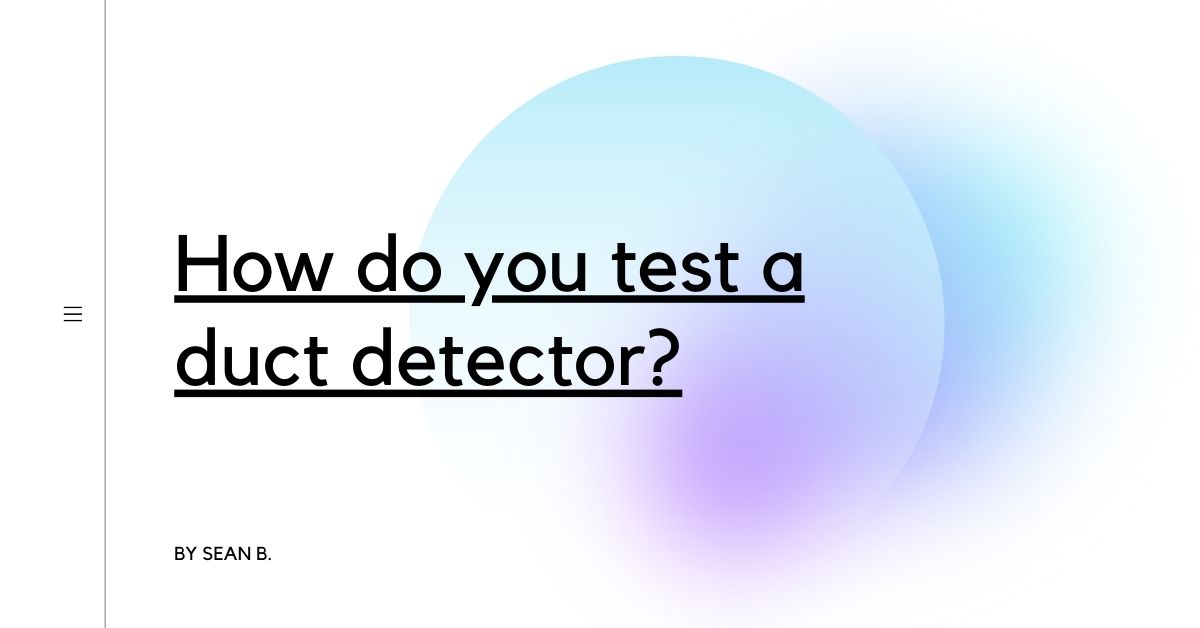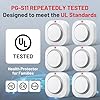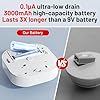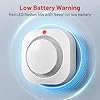Duct detectors are an important part of any commercial or industrial building’s fire safety system, but how do you know if they’re working properly? In this blog post, we’ll show you how to test a duct detector to make sure it’s in good working order.
Contents
Duct detector testing methods
Duct detectors are an important part of any fire safety system, and it is important to ensure that they are working properly. There are a few different methods that can be used to test duct detectors.
One common method is to use a test smoke generator. This device creates a small amount of smoke that is then introduced into the ductwork. The detector should activate when the smoke reaches it.
Another method is to use a heat detector. This type of device is placed in the ductwork and is designed to activate when the temperature rises to a certain level. This can be used to simulate a fire.
Finally, some duct detectors have a built-in self-test feature. This allows the user to test the detector without the need for any additional equipment.
Duct detector testing tips
Duct detectors are an important part of any commercial or industrial building’s fire safety system. They are designed to detect the presence of smoke in the air ducts and trigger the building’s fire alarm system.
There are two main types of duct detectors: ionization and photoelectric. Ionization detectors are more sensitive to smaller particles of smoke, while photoelectric detectors are more sensitive to larger particles.
Testing a duct detector is important to ensure that it is working properly. There are two main ways to test a duct detector: visual inspection and functional testing.
Visual inspection involves looking at the duct detector to make sure that there is no physical damage and that all of the connections are secure. Functional testing involves using a test smoke source to simulate the presence of smoke in the ducts. This can be done with a can of compressed air and a piece of cardboard or with a commercial smoke machine.
When testing a duct detector, it is important to follow the manufacturer’s instructions. In general, the test should be conducted once a month.
Duct detector testing best practices
There are a few different ways that you can test a duct detector to ensure that it is functioning properly. One way is to use a test light. This is a small device that you can purchase at most hardware stores. To use a test light, you will need to first turn off the power to the duct detector.
Once the power is off, you will need to remove the cover of the duct detector. Once the cover is removed, you will need to locate the two wires that are connected to the detector. One of these wires will be connected to the power supply, and the other will be connected to the ground.
You will need to touch the end of the test light to the wire that is connected to the power supply. If the light comes on, then the detector is working properly. If the light does not come on, then the detector is not working properly and will need to be replaced.
Another way to test a duct detector is to use a multimeter. A multimeter is a more sophisticated piece of equipment that can be used to test for a variety of different electrical problems. To use a multimeter to test a duct detector, you will need to first turn off the power to the duct detector.
Once the power is off, you will need to remove the cover of the duct detector. Once the cover is removed, you will need to locate the two wires that are connected to the detector. One of these wires will be connected to the power supply, and the other will be connected to the ground.
You will need to set the multimeter to the “resistance” setting and touch the probes to the two wires. If the multimeter reads “0 ohms,” then the detector is working properly. If the multimeter does not read “0 ohms,” then the detector is not working properly and will need to be replaced.
There are a few different ways that you can test a duct detector to ensure that it is functioning properly. One way is to use a test light. This is a small device that you can purchase at most hardware stores. To use a test light, you will need to first turn off the power to the duct detector. Once the power is off, you will need to remove the cover of the duct detector. Once the cover is removed, you will need to locate the two wires that are connected to the detector.
One of these wires will be connected to the power supply, and the other will be connected to the ground. You will need to touch the end of the test light to the wire that is connected to the power supply. If the light comes on, then the detector is working properly. If the light does not come on, then the detector is not working properly and will need to be replaced.
Another way to test a duct detector is to use a multimeter. A multimeter is a more sophisticated piece of equipment that can be used to test for a variety of different electrical problems. To use a multimeter to test a duct detector, you will need to first turn off the power to the duct detector.
Once the power is off, you will need to remove the cover of the duct detector. Once the cover is removed, you will need to locate the two wires that are connected to the detector. One of these wires will be connected to the power supply, and the other will be connected to the ground.
You will need to set the multimeter to the “resistance” setting and touch the probes to the two wires. If the multimeter reads “0 ohms,” then the detector is working properly. If the multimeter does not read “0 ohms,” then the detector is not working properly and will need to be replaced.
There are a few different ways that you can test a duct detector to ensure that it is functioning properly. One way is to use a test light. This is a small device that you can purchase at most hardware stores. To use a test light, you will need to first turn off the power to the duct detector. Once the power is off, you will need to remove the cover of the duct detector.
Once the cover is removed, you will need to locate the two wires that are connected to the detector. One of these wires will be connected to the power supply, and the other will be connected to the ground. You will need to touch the end of the test light to the wire that is connected to the power supply.
If the light comes on, then the detector is working properly. If the light does not come on, then the detector is not working properly and will need to be replaced.
Another way to test a duct detector is to use a multimeter. A multimeter is a more sophisticated piece of equipment that can be used to test for a variety of different electrical problems. To use a multimeter to test a duct detector, you will need to first turn off the power to the duct detector.
Duct detector testing FAQs
Duct detectors are an important part of any fire safety system, and it is important to know how to properly test them to ensure they are working correctly. Here are some common questions about duct detector testing:
How often should I test my duct detectors?
It is typically recommended to test duct detectors once a month. However, you should check with your local fire code to see if there are any specific requirements for your area.
What type of test should I perform on my duct detectors?
There are two main types of tests that can be performed on duct detectors: functional and sensitivity. Functional testing simply checks to see if the detector is able to detect smoke. Sensitivity testing is a more comprehensive test that measures the amount of smoke required to trigger the detector.
How do I test a duct detector?
To test a duct detector, you will need to have a smoke source. A common smoke source is an incense stick. Place the incense stick in the path of the detector and observe the detector. For a functional test, you should see the detector activate when the smoke enters the detection zone. For a sensitivity test, you will need to measure the amount of smoke required to trigger the detector.
What should I do if my duct detector fails a test?
If your duct detector fails a test, you should contact a qualified fire safety professional to service the unit.
Duct detector testing resources
Duct detectors are an important part of a fire safety system, and it is important to ensure that they are functioning properly. There are a few different ways to test a duct detector:
- Use a test lamp. This is a special lamp that emits a bright light. Shine the light into the detector’s sensing chamber. The detector should activate within a few seconds.
- Use a test smoke. This is a special type of smoke that is designed specifically for testing fire detectors. Activate the smoke and hold it close to the detector. The detector should activate within a few seconds.
- Use a test aerosol. This is a small device that produces a small amount of heat. Hold the consol close to the detector. The detector should activate within a few seconds.
- Use a test tone. This is a special tone that is produced by a test tone generator. Activate the tone and hold it close to the detector. The detector should activate within a few seconds.
- Use a test fire. This is the most extreme test and should only be done if all other tests have failed. Set a small fire in a fireproof container. Hold the container close to the detector. The detector should activate within a few seconds.
Duct detector testing case studies
Duct detectors are an important life safety device that are installed in HVAC systems to provide early warning of a fire. They are required to be tested in accordance with NFPA 72 to ensure they are functioning properly. There are two main types of duct detector tests: functional testing and sensitivity testing.
Functional testing is performed to verify that the detector will activate when exposed to the proper level of smoke. This is typically done by using a smoke machine to introduce a controlled amount of smoke into the ductwork. The detector should activate within the specified time and send a signal to the fire alarm panel.
Sensitivity testing is performed to verify that the detector will activate at the proper level of smoke. This is typically done by using a calibrated smoke test instrument to introduce a controlled amount of smoke into the ductwork. The detector should activate within the specified time and send a signal to the fire alarm panel.
Duct detector testing news
When it comes to testing a duct detector, there are a few different methods that can be used. The most common method is to use a calibrated test meter that is specific for testing this type of device. This meter will send a signal through the device being tested and will measure the time it takes for the signal to return. The results of the test will then be displayed on the meter.
Another common method for testing a duct detector is to use an air flow meter. This device will measure the air flow through the ductwork and will provide a reading on the meter. This method is often used in conjunction with the calibrated test meter method to provide a more accurate reading.
Once the test is complete, the results should be recorded in a log so that they can be reviewed at a later date. It is important to keep track of the results of the tests so that any trends can be identified. If there are any problems with the duct detector, it is important to have a record of the tests so that the problem can be corrected.
Summary
Duct detectors are used to sense the presence of smoke in air ducts and are an important part of a fire safety system. But how do you test a duct detector to make sure it’s working properly?
There are two main types of duct detectors: ionization and photoelectric. Ionization detectors are more sensitive to smaller particles of smoke, while photoelectric detectors are more sensitive to larger particles.
To test an ionization duct detector, you can use a piece of smoldering paper or a smoke bomb. To test a photoelectric duct detector, you can use a laser smoke detector tester.
For either type of detector, it’s important to test in all the areas where the detector is installed, including any dead-end branches. That way, you can be sure that the detector will sense smoke in all the areas it’s supposed to.



















